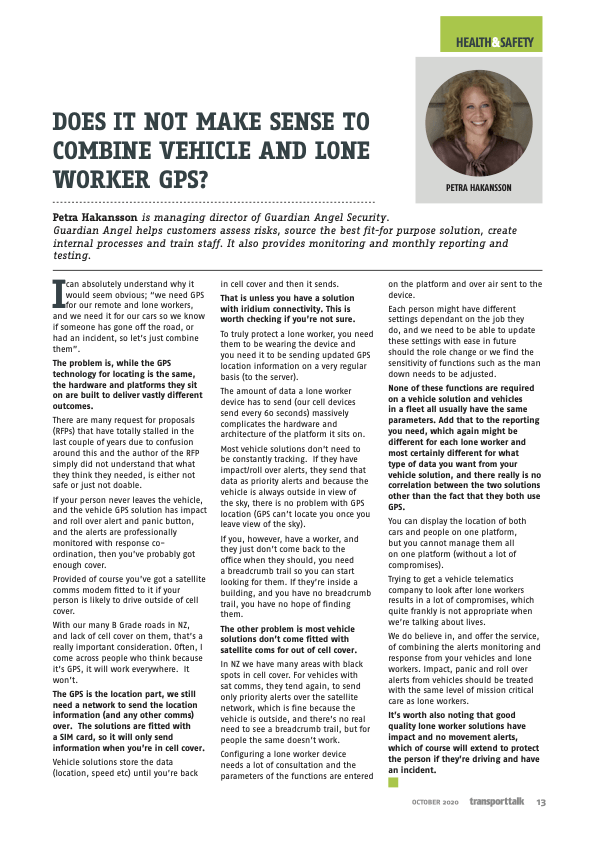I can absolutely understand why it would seem obvious; “we need GPS for our remote and lone workers, and we need it for our cars so we know if someone has gone off the road, or had an incident, so let’s just combine them”. The problem is, while the GPS technology for locating is the same, the hardware and platforms they sit on are built to deliver vastly different outcomes. There are many RFP’s that have totally stalled in the last couple of years due to confusion around this and the author of the RFP simply did not understand that what they think they needed, is either not safe or just not doable.
If your person never leaves the vehicle, and the vehicle GPS solution has impact and rollover alert and panic button, and the alerts are professionally monitored with response co-ordination, then you’ve probably got enough cover. Provided of course you’ve got a satellite comms modem fitted to it if your person is likely to drive outside of cell cover. With our many B Grade roads in NZ and lack of cell cover on them, that’s a really important consideration. Often, I come across people who think because it’s GPS, it will work everywhere. It won’t. The GPS is the location part, we still need a network to send the location information (and any other comms) over. The solutions are fitted with a SIM card, so it will only send information when you’re in cell cover. Vehicle solutions store the data (location, speed etc) until you’re back in cell cover and then it sends. That is unless you have a solution with iridium connectivity. This is worth checking if you’re not sure.
To truly protect a lone worker, you need them to be wearing the device and you need it to be sending updated GPS location information on a very regular basis (to the server). The amount of data a lone worker device has to send (our cell devices send every 60sec) massively complicates the hardware and architecture of the platform it sits on. Most vehicle solutions don’t need to be constantly tracking. If they have impact/roll over alerts, they send that data as priority alerts and because the vehicle is always outside in view of the sky, there is no problem with GPS location (GPS can’t locate you once you leave view of the sky). If you, however, have a worker, and they just don’t come back to the office when they should, you need a breadcrumb trail so you can start looking for them. If they’re inside a building, and you have no breadcrumb trail, you have no hope of finding them. The other problem is most vehicle solutions don’t come fitted with satellite coms for out of cell cover. In NZ we have many areas with black spots in cell cover. For vehicles with sat comms, they tend again, to send only priority alerts over the satellite network, which is fine because the vehicle is outside, and there’s no real need to see a breadcrumb trail, but for a people the same doesn’t work.
Configuring a lone worker device needs a lot of consultation and the parameters of the functions are entered on the platform and over air sent to the device. Each person might have different settings dependant on the job they do, and we need to be able to update these settings with ease in future should the role change or we find the sensitivity of functions such as the man down needs to be adjusted. None of these functions are required on a vehicle solution and vehicles in a fleet all usually have the same parameters. Add that to the reporting you need, which again might be different for each lone worker and most certainly different for what type of data you want from your vehicle solution, and there really is no correlation between the two solutions other than the fact that they both use GPS.
You can display the location of both, cars and people on one platform, but you cannot manage them all on one platform (without a lot of compromises). Trying to get a vehicle telematics company to look after lone workers results in a lot of compromises which quite frankly is not appropriate when we’re talking about lives. We do believe in, and offer the service, of combining the alerts monitoring and response from your vehicles and lone workers. Impact, panic and rollover alerts from vehicles should be treated with the same level of mission-critical care as lone workers. It’s worth also noting that good quality lone worker solutions have impact and no movement alerts, which of course will extend to protect the person if they’re driving and have an incident.




